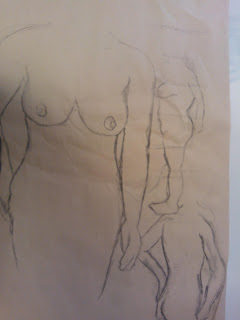today we had a full body life drawing session, we had to draw from a nude model and this proved to be quite challenging, we started with a drawing a two poses both in which we only had 15 minutes, for our first drawing we were instructed to use pencil and then for the second we were told to use charcoal. The main problem with my first drawings is that parts of the body are out of proportion.
For the second drawing we were shown a method of measuring using our pencils where we measured the height of the head which would become one section and then measure down the body with the same scale to get the correct length of the body and this proved to be very useful and improved the quality of my work. As i became more comfortable with my drawing i began to use the side of my charcoal to add marks to the body as it gave a lighter more shadowed effect.

We were then allowed a short break from our drawing to research into Leonardo Da Vinci's work such as "vitruvian man" which was a way of working out proportion that relates to architecture, after researching into this we returned back to drawing which was still becoming easier the more i did it, this time we were told to do different scaled images and try and fit three to a page, we were given 20 minutes for the first and then 10 minutes for the other two. For the 10 minute ones i focused on key lines that made the figure clear rather than focusing on the details.
for the final three drawings we had to do we were given only 5 minutes for each which i thought would be quite challenging but was actually easy when i put my full focus and attention into it and i was quite pleased with the result i got and learning the pencil proportion skill really helped, as well as looking into Da Vinci's work .
On Tuesday the12th march a week after our first full body session we had another session but this time with an older male model, the same techniques were applied but the male body was much more square and muscular than the females and so it had more tones and lines.
in this session we drew from poses that we had not previously seen and drew certain sections of the body in a larger scale with quite a lot of detail.
The following week we had our third life drawing session, for this we had the male model again, we started out by doing two large 10 minute charcoal drawings just to get us warmed up, i was quite disappointed with my first two drawings as some of the body parts were drawn too thin or fat.
for our third drawing we were given an hour and a half, we had to draw one image that was the full a2 size and then collage it to create tones on the body for example to show muscles and shadows, i chose to use cartridge paper as my base to draw on and then using a glue stick and watered down PVA glue i layered brown paper, black and white print and tissue paper i also used masking tape for some tones as well and i feel that this was quite effective. I was very pleased with how it was coming together as a piece of work but i failed to work quick enough so was unable to finish it in the set time period.
 Leonardo Da Vinci was an italian man with many different occupations, such as architecture, painting and sculpting and engineering. Leonardo used architectural techniques to create an ink drawing of a man which was named the Vitruvian man this piece of work shows a man inside a circle inside a square and without looking into the methods behind this piece it is unclear as to why he did this but when you read into it and look at the piece in more depth you realize that it is to do with proportion and measurement, the measured that Da Vinci used are listed below.
Leonardo Da Vinci was an italian man with many different occupations, such as architecture, painting and sculpting and engineering. Leonardo used architectural techniques to create an ink drawing of a man which was named the Vitruvian man this piece of work shows a man inside a circle inside a square and without looking into the methods behind this piece it is unclear as to why he did this but when you read into it and look at the piece in more depth you realize that it is to do with proportion and measurement, the measured that Da Vinci used are listed below.







